|
Subsonic Bullets
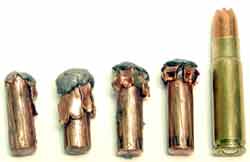 Subsonic bullets are useful not only for military covert operations, but for animal control officers and others who need to use a nearly silent or legal suppressed firearm to avoid alarming other animals, upsetting nearby livestock, or bothering the neighbors. Sometimes the use of a suppressed weapon in civilian animal control situations is politically wise, as it allows the necessary use of firearms without attracting undue attention from irrational activist groups. Subsonic bullets in legal suppressed firearms are also fun to shoot for target practice, eliminating the sonic crack that requires hearing protection, distrubs neighbors, and frightens livestock.
Subsonic bullets are useful not only for military covert operations, but for animal control officers and others who need to use a nearly silent or legal suppressed firearm to avoid alarming other animals, upsetting nearby livestock, or bothering the neighbors. Sometimes the use of a suppressed weapon in civilian animal control situations is politically wise, as it allows the necessary use of firearms without attracting undue attention from irrational activist groups. Subsonic bullets in legal suppressed firearms are also fun to shoot for target practice, eliminating the sonic crack that requires hearing protection, distrubs neighbors, and frightens livestock.
 The principle problem which subsonic bullet design must overcome is lack of expansion at low velocity. With single shots and revolvers, the tip can be made with exposed lead and a large hollow point cavity. In magazine-fed firearms, the tip needs be strong enough to handle feeding pressures, which often eliminates large hollow point lead tips. Therefore, the jacket needs to come to the end of the bullet, and the hollow point down inside the core, which is inside the jacket (not exposed as in a lead tip).
The principle problem which subsonic bullet design must overcome is lack of expansion at low velocity. With single shots and revolvers, the tip can be made with exposed lead and a large hollow point cavity. In magazine-fed firearms, the tip needs be strong enough to handle feeding pressures, which often eliminates large hollow point lead tips. Therefore, the jacket needs to come to the end of the bullet, and the hollow point down inside the core, which is inside the jacket (not exposed as in a lead tip).
A sharp spitzer point brings the jacket material toward the tip in a strong tapered column, which tends to prevent or delay expansion. Since most of the drag on a subsonic bullet is on the base, rather than the tip, the nose can be as blunt as possible (to still permit reliable feeding). The more blunt (round) the tip, the more easily it can be expanded on impact (with a hollow point design). The 1-E elliptical ogive typically gives good feeding in most rifles. The 3/4-E ogive works in nearly all handguns.
 At very low velocity, the jacket may prevent expansion even with a good-sized hollow point cavity and a blunt nose. Using a SDD-2 jacket serrator die to put six shallow cuts in the OD of the jacket provides stress-riser lines, so that the bullet will peel back evenly along these slightly weaker points on impact. The cuts need only be .010 to .015 inches deep in order to provide excellent performance even at velocities as low as 750-800 fps with proper sized hollow cavity and nose shape, with the .300 Whisper using Corbin J-30-125 jackets.
At very low velocity, the jacket may prevent expansion even with a good-sized hollow point cavity and a blunt nose. Using a SDD-2 jacket serrator die to put six shallow cuts in the OD of the jacket provides stress-riser lines, so that the bullet will peel back evenly along these slightly weaker points on impact. The cuts need only be .010 to .015 inches deep in order to provide excellent performance even at velocities as low as 750-800 fps with proper sized hollow cavity and nose shape, with the .300 Whisper using Corbin J-30-125 jackets.
The SDD-1 serrator is a full length style, which is only suitable for flat base bullets. For RBT bases, the SDD-2 adjustable length serrator must be used to avoid putting serrations in the rebate junction.
The Rebated Boattail is not a necessity for short to moderate range bullets. It helps retain energy to support expansion, which is potentially more valuable at ranges beyond 100 yards. The following example 218 grain 30 Whisper bullets are flat base design, which permits the use of more weight in the same jacket length compared to a RBT base. (With RBT, the same bullet design and over-all length would be in the 185-190 grain range.)
Another factor in the design of subsonic bullets is the weight. The energy a bullet carries comes from the product of the mass and square of the velocity. If the velocity is below 1/3 that of a conventional supersonic bullet, around 1000 fps or less, then the energy with the same weight is considerably reduced. To gain some of it back, the weight of the bullet is generally increased. This is permissable because with lower velocity, the powder charge is reduced and the pressure is also reduced, meaning that more inertia can be allowed in the projectile without over-stressing the firearm. Too heavy a bullet would usually make the bullet so long that it might not be stable without a faster twist rate, but a somewhat heavier than usual bullet moving at low velocity, with a fairly round nose to shift the center of gravity forward, can be quite stable in a standard twist rifle.
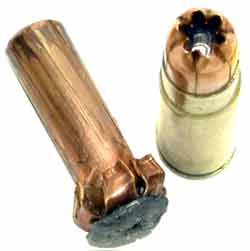
|
These 218 grain .308 bullets were made by The Bullet Depot,6785 Hwy 62, White City, OR 97503, using Corbin swaging equipment. They were fired into Corbin Sim-Test(tm) Simulated Muscle Tissue ballistic test media.
(Corbin Manufacturing thanks The Bullet Depot (541-826-2999) for the use of the photos and information.)
|
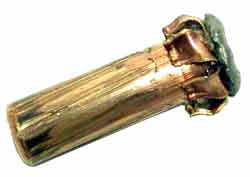
|
Velocity: 750 fps
Penetration: 10-in.
Retained Weight: 218 gr.
Expansion: 1.5x
|
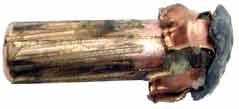
|
Velocity: 942 fps
Penetration: 10-in.
Retained Weight: 218 gr.
Expansion: 1.75x
|
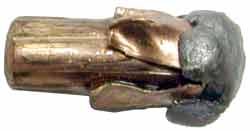
|
Velocity: 1028 fps
Penetration: 10-in.
Retained Weight: 218 gr.
Expansion: 2x
|
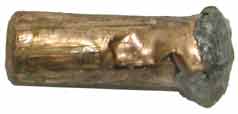
|
Velocity: 1821 fps
Penetration: 12-in.
Retained Weight: 208 gr.
Expansion: 1.5x
|
|
The equipment necessary to make long range subsonic rifle bullets in calibers from .14 to .458 is:
- CSP-1 S-Press
- RBTO-4-S Rebated Boattail Open Tip die set
- PUNCH-S core seat external hollow point open tip
- PUNCH-ST core seat internal Saber-Tooth(tm)
- SDD-2-S full length jacket serrator die
- CSL-2 swage lube
- LW-10 lead wire, 70,000 grain spool
- PCS-1 core cutter for above wire diameter
- Appropriate size jackets or jacket maker
For lead tip bullets (single shot or revolver), an even more effective design is the X-cut core with Saber Tooth LT-HP design. To make this bullet, change the above items to:
- RBTL-5-S 5-die RBT Lead tip die set instead of RBTO-4
- PUNCH-S core seat external hollow point lead tip (vs open tip)
- PUNCH-SX core swage external X-punch
In the X-cut core, a little swage lube is inserted into the X cut prior to a second seating operation with the HP-LT punch. This prevents the X-cut from sticking together, even though it looks as if the cut is closed again by pressing with the HP punch.
The bullet jackets for .308 can be Corbin J-30-125 versatile benchrest jackets. For calibers in the .257 to .284 range (anything smaller than 30 and larger than 6mm) the same jacket can be used with one or more JRD-1-S jacket draw dies, and an ET-2-S jacket trim die.
For jackets larger than .308, one can use pistol jackets (such as a .44 drawn to 8mm with two JRD-1-S draw dies, and trimmed with an ET-2-S trim die) or copper tubing with the CTJM-1-S tubing jacket maker kit. Copper tubing will need to be thinned or serrated more heavily than a commercial drawn jacket, to give satisfactory expansion.
For calibers of 6mm and smaller, the Corbin J-6m-102 jacket can be used, and drawn to 224 for a long, heavy bullet, in some cases without a trim die. For long, heavy 20, 19, or 17 bullets, a Corbin J-22-705 jacket can be used with a JRD-1-S. A trim die may not be required.
Prices for all of the items listed can be found at corbins.com/prices.htm.
|



